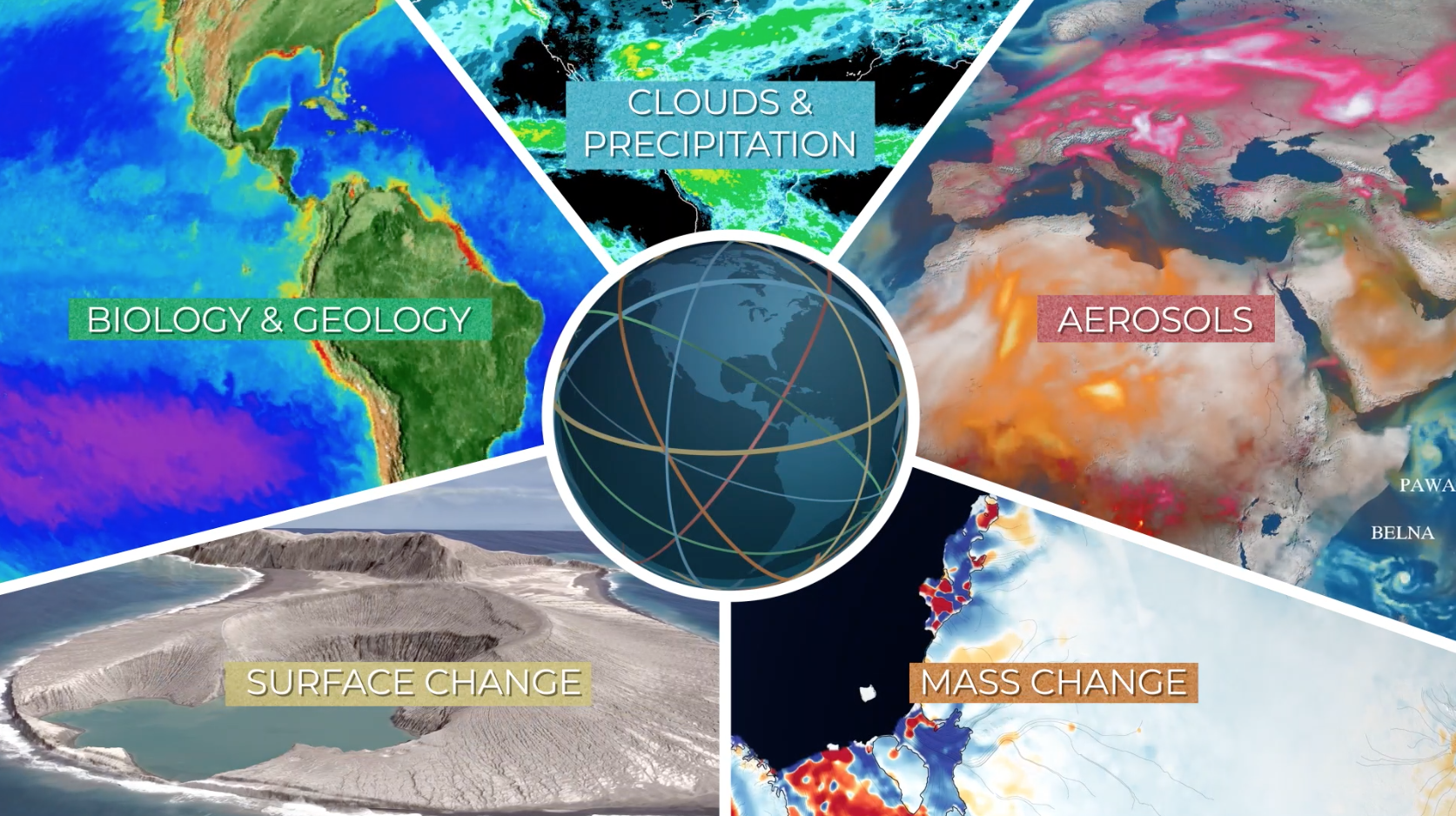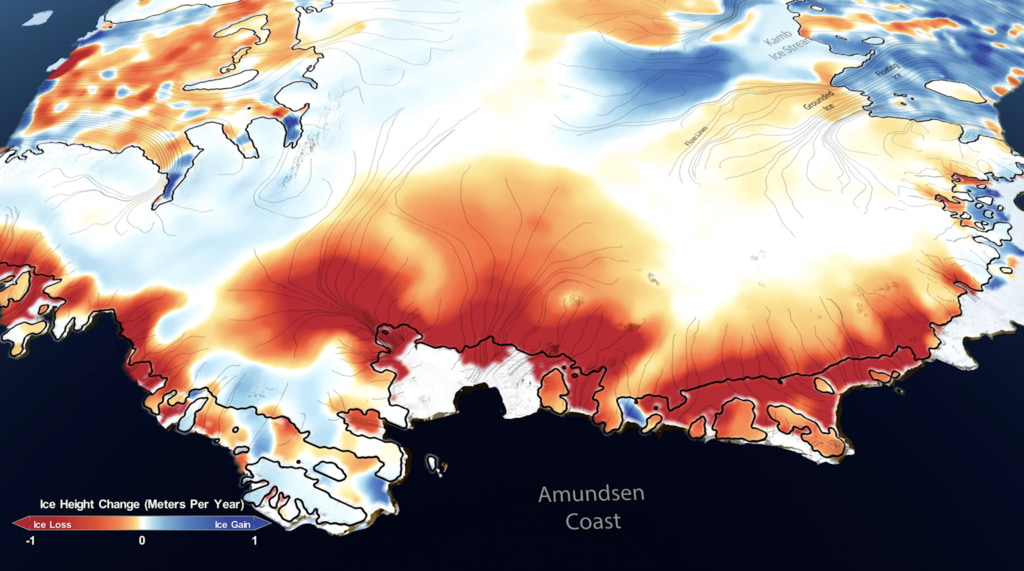Land Ice Height Change Between ICESat and ICESat-2
This visualization depicts changes in Antarctic land ice thickness as measured by the ICESat (2003-2009) and ICESat-2 (2018-) satellites. The camera zooms into a region near the Kamb ice stream to compare ICESat and ICESat-2 beam tracks. The beam intersections are highlighted to explain how the data at these points are used to measure how land ice has changed over time. After exploring a few regions in detail, the camera moves out to a global view and an ocean temperature dataset is revealed.
The future response of the Antarctic Ice Sheet to changes in climate is the single largest source of uncertainty in projections of sea level rise. If the ice sheet melted completely it would raise sea levels by 57 meters, a process that would unfold over millennia. One key to understanding how the ice sheet will respond in the future is to observe and analyze how the ice sheet has reacted to changes in climate over the past decades, where satellites observations are available. One key to understanding ice sheet change is to examine records of elevation change that show where the ice sheet is thinning and thickening due to changing environment. Recent analysis of incredibly precise surface elevations collected by NASA’s ICESat and ICESat-2 satellite laser altimeters reveals complex patters of ice sheet and ice shelf (floating extensions of the ice sheets) change that are the combined consequence of changes in melting by the ocean, changes in precipitation and, changes at the bed of the glacier where the ice sheet slides across the underlying bedrock. The researchers do this my finding locations where tracks of measured elevation intersect, measuring the change in elevation and correct for changes in the average density of the surface using models.
Coherent regional patters of elevation change reveal the underlying mechanism responsible causing ice sheet change. One of the most striking features in the data is the Kamb Ice Stream that once flowed rapidly into the Ross Ice Shelf but that stopped flowing due to an increase friction (resistance to flow) likely caused by changes in the availability of liquid water at its base. Strong patters of thinning are visible all along the Amundsen Cost where ice shelves are rapidly thinning in response to increased melting by warm ocean waters. Melting of ice shelves do not directly contribute to changes in sea level, since they are already floating, but they do indirectly impact how fast the grounded ice is able to flow into the ocean. Ice shelves are located at the fronts of the glaciers and help to regulate how fast the ice flows into the ocean. As the ice shelves thin they become less able to hold back the inland ice, causing the grounded glaciers to accelerate and thin. In the East, broad patters of thickening reveal that the East Antarctic Ice Sheet is growing most likely in response to increases in precipitation relative to some unknown time in the past. The thickening is strongest along the coast of Dronning Maud Land where enhanced moisture transport has resulted in increased snowfall.
Despite the diversity of gains and losses, losses in the West (208 cubic kilometers of water per year or Gt) greatly outpace Gains (90 Gt per year) in the east resulting in a total Antarctic mass change loss of 118 Gt per year.
This visualization depicts changes in Greenland land ice thickness as measured by the ICESat (2003-2009) and ICESat-2 (2018-) satellites. The camera zooms into a region near the Zachariae Isstrom glacier to compare ICESat and ICESat-2 beam tracks. The beam intersections are highlighted to explain how the data at these points are used to measure how land ice has changed over time.
As the Greenland Ice Sheet responds to warming oceans and atmosphere it has become one of the largest contributors to sea level rise and will continue to be for the foreseeable future. Scientists are working to determine more precisely how much more ice will be lost and when that loss will occur. One key approach to doing this is to analyze changes in the ice sheets elevation over the past decades where satellite observations are available. By finding the intersection of elevation track measurements collected by NASA’s ICESat (2003-2009) and ICESat-2 (2018-) satellite laser altimeters, researchers are able to make very precise measurements of elevation change that can be converted to estimates of mass change after correcting for changes snow density using models.
The combination of long time-span between measurements and the high accuracy of NASA’s satellite laser altimeters allows the researchers to make highly detailed maps of mass change that provide insights into the mechanism behind the ice sheets rapid rate of loss. Thinning can be seen around the periphery of the ice sheet where elevations are closest to sea level and rates of surface melting are highest. This pattern is punctuated by localized areas of extreme thinning where large glaciers come into contact with warm ocean waters. Unlike the uniform pattern of low-elevation thinning that is being driven by increased melting due to warmer summer air temperatures, these concentrated areas of thinning occur where outlet glacier have sped up. These glaciers have sped up in response to some combination of retreating ice front position, changes in the slipperiness at the bed of the glacier due to changes in liquid water at the ice-rock interface and due to change in the rate frontal melting due to an increase in the heat content of the ocean waters that come into contact with the glacier front.
Juxtaposed on the pattern of rapid thinning along the periphery of the ice sheet is a broad pattern of thickening in the high-elevation interior of the ice sheet. This pattern of thickening suggests that increases in snowfall, relative to sometime in the past, are partly compensating for increased losses due to enhanced melt and accelerated glacier flow. Overall low-elevation losses greatly outpace high-elevation gains resulting in 3200 cubic kilometers of water (Gt) being lost from the ice sheets and entering the oceans, raising global mean sea level by 8.9 mm.

This high resolution still image depicts changes in Antarctic land ice thickness as measured by the ICESat (2003-2009) and ICESat-2 (2018-) satellites.

This high resolution still image depicts changes in Greenland land ice thickness as measured by the ICESat (2003-2009) and ICESat-2 (2018-) satellites.
Credits
Please give credit for this item to:
NASA's Scientific Visualization Studio
-
Visualizer
-
Kel Elkins
(USRA)
-
Kel Elkins
(USRA)
-
Producer
- Ryan Fitzgibbons (USRA)
-
Scientists
- Thomas A. Neumann (NASA/GSFC)
- Alex S. Gardner (NASA/JPL CalTech)
- Benjamin E. Smith (University of Washington Applied Physics Lab Polar Science Center)
- Helen Amanda Fricker (Scripps Institution of Oceanography, University of California, San Diego)
Series
This page can be found in the following series:Datasets used
-
[ICESat: GLAS]
ID: 38
Note: While we identify the data sets used on this page, we do not store any further details, nor the data sets themselves on our site.
Release date
This page was originally published on Thursday, April 30, 2020.
This page was last updated on Wednesday, May 14, 2025 at 12:10 AM EDT.



